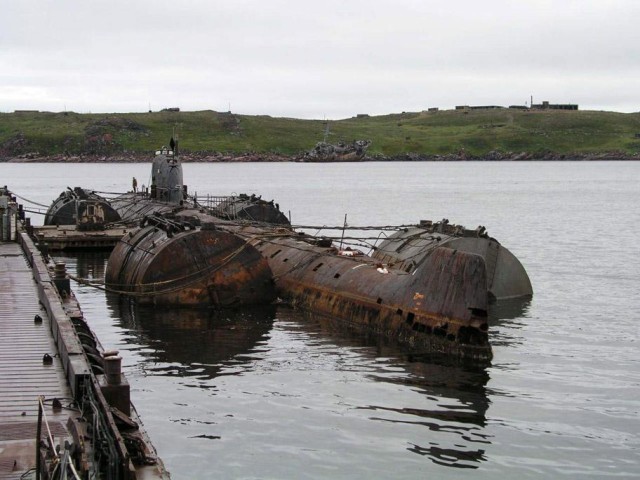
New Managing Director for Bellona Norway
The Board of the Bellona Foundation has appointed former Minister of Climate and the Environment Sveinung Rotevatn as Managing Director of Bellona No...
News
Publish date: February 6, 2003
News
Approximately two thirds of all nuclear-powered vessels are assigned to the Northern Fleet at the Kola Peninsula. The remainder are based at Pacific Fleet bases in the Russian Far East.
From the time that the first nuclear powered submarine, Leninsky Komsomol (K-3) first entered service in 1959, the cold war arms race developed far too fast for the Soviet authorities to plan how to dispose of the nuclear waste that would be generated both from the operating vessels, and later, from the decommissioning of the submarines. During the cold war, six new naval bases with nuclear submarine facilities were created along the ice-free cost of the Kola Peninsula. Over the course of the ensuing years, six naval yards were built or refitted on the Kola Peninsula and in Severodvinsk for the construction and maintenance of nuclear submarines. Most of the spent nuclear fuel and radioactive waste were accumulated at the naval yards and submarine bases, except for the waste which was dumped in the Barents and Kara Seas.
The development of infrastructure for handling and storing spent nuclear fuel and radioactive waste at the bases and naval yards lagged far behind the rate at which the submarines themselves were being built. A certain number of facilities for the handling and treatment of radioactive waste existed only on the drawing board. Construction of many facilities for the treatment and storing of waste was started, but never completed, and of the facilities that actually were built, many have been taken out of service, such as the spent nuclear fuel storage at Andreeva Bay and in Gremikha, for example.
Following the disintegration of the Soviet Union in 1991, the Northern Fleet has undergone significant changes. From the peak in the late 1980s with more than 120 nuclear powered submarines in operation, there are less than 40 submarines in operation in the Northern Fleet in 2001.
The overhanging danger of accidents and radioactive leakage from laid-up nuclear powered submarines and run-down storage sites for spent nuclear fuel and radioactive waste increase from year to year. Both from an environmental and economic perspective, it is important that the decommissioning of the nuclear powered submarines and the securing of storage sites for spent nuclear fuel and radioactive waste is undertaken quickly.
One of the major challenges in the handling of radioactive waste and spent nuclear fuel is the sheer number of the locations where these activities take place. The lack of a central storage and handling facility makes the whole process very ineffective. Below is an overview of the various naval bases and shipyards where spent nuclear fuel and radioactive waste are managed.
From the time that the first nuclear powered submarine, Leninsky Komsomol (K-3) first entered service in 1959, the cold war arms race developed far too fast for the Soviet authorities to plan how to dispose of the nuclear waste that would be generated both from the operating vessels, and later, from the decommissioning of the submarines. During the cold war, six new naval bases with nuclear submarine facilities were created along the ice-free cost of the Kola Peninsula. Over the course of the ensuing years, six naval yards were built or refitted on the Kola Peninsula and in Severodvinsk for the construction and maintenance of nuclear submarines. Most of the spent nuclear fuel and radioactive waste were accumulated at the naval yards and submarine bases, except for the waste which was dumped in the Barents and Kara Seas.
The development of infrastructure for handling and storing spent nuclear fuel and radioactive waste at the bases and naval yards lagged far behind the rate at which the submarines themselves were being built. A certain number of facilities for the handling and treatment of radioactive waste existed only on the drawing board. Construction of many facilities for the treatment and storing of waste was started, but never completed, and of the facilities that actually were built, many have been taken out of service, such as the spent nuclear fuel storage at Andreeva Bay and in Gremikha, for example.
Following the disintegration of the Soviet Union in 1991, the Northern Fleet has undergone significant changes. From the peak in the late 1980s with more than 120 nuclear powered submarines in operation, there are less than 40 submarines in operation in the Northern Fleet in 2001.
The overhanging danger of accidents and radioactive leakage from laid-up nuclear powered submarines and run-down storage sites for spent nuclear fuel and radioactive waste increase from year to year. Both from an environmental and economic perspective, it is important that the decommissioning of the nuclear powered submarines and the securing of storage sites for spent nuclear fuel and radioactive waste is undertaken quickly.
One of the major challenges in the handling of radioactive waste and spent nuclear fuel is the sheer number of the locations where these activities take place. The lack of a central storage and handling facility makes the whole process very ineffective. Below is an overview of the various naval bases and shipyards where spent nuclear fuel and radioactive waste are managed.

The Board of the Bellona Foundation has appointed former Minister of Climate and the Environment Sveinung Rotevatn as Managing Director of Bellona No...

Økokrim, Norway’s authority for investigating and prosecuting economic and environmental crime, has imposed a record fine on Equinor following a comp...

Our op-ed originally appeared in The Moscow Times. For more than three decades, Russia has been burdened with the remains of the Soviet ...

The United Nation’s COP30 global climate negotiations in Belém, Brazil ended this weekend with a watered-down resolution that failed to halt deforest...